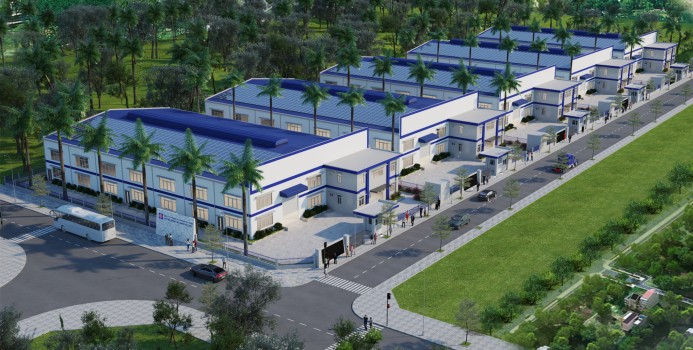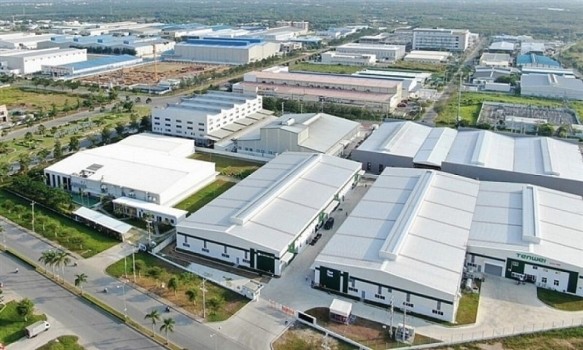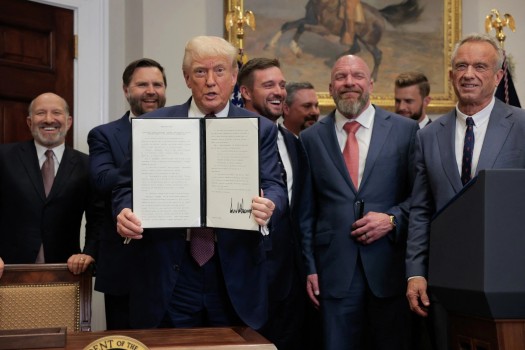VIETNAM AFFIRMS ITS POSITION AS A GLOBAL TRADE AND MANUFACTURING HUB
A Reliable Trade Partner and a Key Link in the Supply Chain
The image of workers processing frozen shrimp in factories across Vietnam demonstrates the country 's strong production capacity for exports. In 2023, the total import-export turnover exceeded $683 billion, propelling Vietnam into the group of the top 20 trading economies in the world.
Notably, exports have maintained an impressive growth momentum, with merchandise turnover in 2024 projected to reach approximately $405.5 billion, a 14.3% increase from 2023. With this continuous export growth, Vietnam has recorded a trade surplus for nine consecutive years, affirming the competitiveness and resilience of its outward-looking economy.
"Made in Vietnam" smartphones have become a key export product, helping Vietnam assert its position in the global technology supply chain. Minister of Industry and Trade Nguyen Hong Dien emphasized that Vietnam is "always ready to be a reliable partner in the global supply chain" and is committed to collaborating to build a fair, adaptive, and sustainable trade environment.
In fact, major multinational corporations like Samsung, Apple, and Intel have established large-scale production facilities in Vietnam, making the country an indispensable link in the global manufacturing network.

Vietnam has also actively participated in new-generation free trade agreements (FTAs) such as the CPTPP, EVFTA, and RCEP, which have significantly expanded its export markets, lowered tariffs, and enhanced the nation 's reputation on the international stage. Thanks to its favorable geopolitical position—bordering China and located on a major maritime route—along with its reform and open-door policies, Vietnam has attracted a strong flow of investment, becoming a “China+1” hub for industrial manufacturing. Major tech companies have helped Vietnam deepen its participation in the production chains of electronics and high technology.
Reports indicate that the group of computers, electronic products, and components reached a turnover of $72.56 billion in 2024, a 26.6% increase from 2023. Vietnam is currently the world 's second-largest smartphone exporter, trailing only China, and accounts for approximately 12% of the global market share. Beyond electronics, the consistent growth in textiles, footwear, and agricultural products has solidified Vietnam 's role as a key hub in the global supply chain, providing a diverse range of products to various markets.
Balancing U.S. - China - Vietnam Relations
The processing of exported tra fish in Vietnam—a product that benefits from the U.S. market while relying on raw materials from China—illustrates the intertwined interests within the supply chain. Amid the strategic competition between the U.S. and China, Vietnam has skillfully maintained a balanced cooperative relationship with both superpowers to maximize economic development opportunities.
With the United States, the bilateral relationship was upgraded to a Comprehensive Strategic Partnership in September 2023, the highest level in Vietnam 's diplomatic hierarchy. The U.S. is now Vietnam 's largest export market, accounting for an increasing share of total turnover. In 2024, exports to the U.S. reached approximately $119.6 billion, leading to a record trade surplus of $104.6 billion. Washington considers Vietnam a crucial partner in its strategy to "strengthen reliable supply chains." The U.S. President 's visit to Vietnam in 2023 emphasized high-tech cooperation, particularly building a secure semiconductor supply chain between the two countries.
In parallel, Vietnam maintains a close cooperative relationship with China—its largest trading partner in terms of total turnover. China supplies about one-third of Vietnam 's import value, primarily electronic components and textile raw materials. Vietnam also advocates for diversifying import sources to reduce dependency while leveraging the RCEP agreement to optimize rules of origin, thereby strengthening regional supply chain linkages. The favorable rules of origin under RCEP are facilitating the formation of an Asia-Pacific supply chain, bringing clear benefits to Vietnam.
On the political front, high-level leaders of both countries maintain regular dialogue, which helps reinforce the spirit of "friendly neighbors, cooperating for common development" and ensures smooth bilateral supply chains.
According to expert Andrea Coppola (World Bank), the U.S.-China tensions have had a positive impact on Vietnam 's trade, helping the country expand its export market for electronics and machinery to the U.S. However, Vietnam is also aware of the challenges posed by the U.S. 's tightening rules of origin to prevent goods from "disguising" their origin to evade tariffs. Therefore, Vietnam is making efforts to meet high standards of origin transparency, labor, and environmental practices to maintain the trust of both major markets in the long term.
Expanding Multilateral Cooperation and Joining Economic Blocs
The pre-processing of durian—an agricultural product that helped Vietnam set a new export record in 2024—demonstrates the effort to diversify export markets. Vietnam is not only focusing on the two superpowers but is also actively expanding multilateral economic relations at multiple levels. Within ASEAN, Vietnam is a dynamic and active member, working with other nations to build the ASEAN Economic Community (AEC) and promote infrastructure connectivity and intra-bloc trade facilitation. Vietnam also participates in regional supply chain initiatives, such as the Mekong–U.S. partnership to develop logistics and supporting industries.
Vietnam has signed a series of comprehensive FTAs, such as the CPTPP with 10 countries and the EVFTA with the EU, creating a vast network of connections from Asia to Europe. Thanks to these new-generation FTAs, "Made in Vietnam" goods can penetrate developed markets (Japan, Canada, Germany, France, etc.) with preferential tariffs, while also attracting more investment capital and technology. Exports to the EU have grown positively since the EVFTA came into effect, making Vietnam the EU 's top trading partner in ASEAN. Participation in the RCEP (15 Asia-Pacific nations) also opens up a massive regional market for Vietnam, encouraging technology transfer and upgrading domestic industries through freer movement of components and raw materials.

Thanks to its multi-layered integration strategy, Vietnam is becoming more deeply embedded in many global supply chains. In textiles and footwear, Vietnam is among the world 's top exporters, serving as a vital supplier for international fashion brands. In electronics and technology, Vietnam has risen to become the world 's second-largest assembly hub for consumer electronic devices, participating in the production of components for major corporations.
In agriculture, Vietnam maintains its top position in exporting rice, coffee, cashews, and seafood, contributing to food and raw material security for many nations. Notably, Vietnam is emerging in the electric vehicle and renewable energy supply chains, attracting projects for the production of batteries, solar panels, and electric cars, such as VinFast 's collaborations with foreign partners. Through its broad network of multilateral partners, Vietnam diversifies its markets and supply sources, increasing its resilience to global volatility.
In late 2024, Vietnam joined the Indo-Pacific Economic Framework (IPEF), initiated by the U.S., to strengthen supply chain linkages and promote digital economy and clean energy in the region. Vietnam also leverages multilateral forums like APEC and the WTO to promote its image as an innovative, dynamic nation and to contribute to shaping global trade rules that align with the interests of developing countries.
Vietnam – An Emerging Supply Chain Partner, Ready to Soar
The 2024-2025 period marks a powerful transformation for Vietnam in its role as a global manufacturing and trade hub. From attracting production shifts and increasing export market share to establishing deep economic ties with superpowers and forging regional links, Vietnam is affirming its position as a reliable and stable partner in the eyes of the international community.
This achievement is the result of the strategic vision and wise leadership of the Communist Party of Vietnam, combined with the unity of the entire political system, business community, and people. The 13th National Congress (2021) set forth the orientation of building an economy that is "independent, self-reliant, and deeply integrated," along with a foreign policy of multilateralism, being a friend and reliable partner to all nations.
Thanks to this sound direction, Vietnam maintains a stable political environment and consistent policies, which builds trust with partners and foreign investors. At the same time, the Party has directed efforts to improve the business environment, invest in infrastructure, and develop human resources to capitalize on opportunities from the global supply chain.
The long-term goal is for Vietnam to become a modern, high-income industrialized nation by 2030 and 2045. Although many challenges lie ahead, such as increasing value-added, green transition, and geopolitical risks, based on the foundation it has built, Vietnam has every reason to continue its ascent.
A confident Vietnam, proactively integrating, and serving as a friend and reliable partner to all nations, is taking clear shape, ready to make a positive contribution to the global supply chain and work with its partners toward sustainable, shared prosperity.
Source: VIR
Nguồn:
Related news

09/08/2025
VIET NAM 'S INDUSTRIAL REAL ESTATE RENT HAS INCREASED BY 70%
VIET NAM 'S INDUSTRIAL REAL ESTATE RENT HAS INCREASED BY 70%

09/08/2025
WILL THE DEMAND FOR INDUSTRIAL REAL ESTATE CONTINUE TO RISE ?
Will the Demand for Industrial Real Estate Continue to Rise?

09/08/2025
U.S. RECIPROCAL TARIFFS OFFICIALLY TAKE EFFECT
U.S. RECIPROCAL TARIFFS OFFICIALLY TAKE EFFECT

09/08/2025
ESG TRENDS IN INDUSTRIAL PARK DEVELOPMENT IN VIET NAM
ESG TRENDS IN INDUSTRIAL PARK DEVELOPMENT IN VIET NAM
Copyright © 2022 Viet Huong IP., Ltd. All Rights Reserved
TOP



